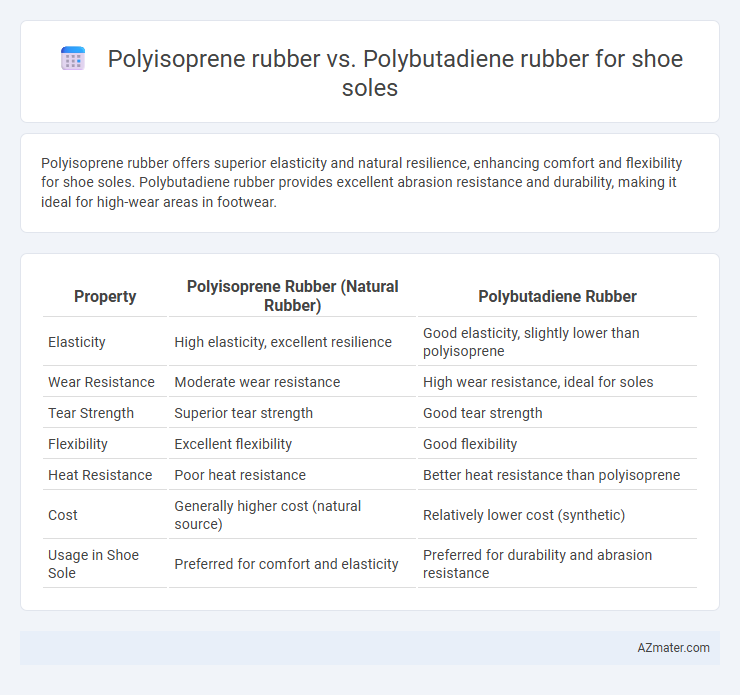Polyisoprene rubber offers superior elasticity and natural resilience, enhancing comfort and flexibility for shoe soles. Polybutadiene rubber provides excellent abrasion resistance and durability, making it ideal for high-wear areas in footwear.
Table of Comparison
| Property | Polyisoprene Rubber (Natural Rubber) | Polybutadiene Rubber |
|---|---|---|
| Elasticity | High elasticity, excellent resilience | Good elasticity, slightly lower than polyisoprene |
| Wear Resistance | Moderate wear resistance | High wear resistance, ideal for soles |
| Tear Strength | Superior tear strength | Good tear strength |
| Flexibility | Excellent flexibility | Good flexibility |
| Heat Resistance | Poor heat resistance | Better heat resistance than polyisoprene |
| Cost | Generally higher cost (natural source) | Relatively lower cost (synthetic) |
| Usage in Shoe Sole | Preferred for comfort and elasticity | Preferred for durability and abrasion resistance |
Introduction to Polyisoprene and Polybutadiene Rubber
Polyisoprene rubber, a synthetic elastomer closely resembling natural rubber, offers excellent elasticity, abrasion resistance, and resilience, making it ideal for shoe soles that require flexibility and comfort. Polybutadiene rubber provides superior wear resistance and low heat buildup, enhancing the durability and performance of shoe soles under high-impact and repetitive stress conditions. The choice between polyisoprene and polybutadiene rubber depends on balancing comfort with durability in footwear applications.
Chemical Structure Comparison
Polyisoprene rubber features a repeating unit derived from isoprene with a cis-1,4 configuration, providing high elasticity and resilience essential for shoe soles. Polybutadiene rubber is composed of butadiene monomers, primarily in cis-1,4 and trans-1,4 forms, offering superior abrasion resistance and low-temperature performance. The chemical structure differences result in polyisoprene's natural rubber-like softness and flexibility, while polybutadiene's structure enhances toughness and wear resistance for durable shoe sole applications.
Physical Properties and Performance
Polyisoprene rubber offers superior elasticity and resilience, closely mimicking natural rubber, which enhances flexibility and comfort in shoe soles. Polybutadiene rubber exhibits higher abrasion resistance and lower heat buildup, providing durability and extended wear life under high-stress conditions. The choice between polyisoprene and polybutadiene rubber depends on whether flexibility or durability is prioritized for specific footwear applications.
Abrasion Resistance in Footwear Applications
Polyisoprene rubber exhibits superior abrasion resistance compared to polybutadiene rubber, making it a preferred choice for shoe soles requiring durability in high-wear environments. The molecular structure of polyisoprene contributes to enhanced elasticity and resilience, which reduces wear from repetitive friction and extends the lifespan of footwear. Polybutadiene rubber, while offering good flexibility and impact resistance, generally shows lower abrasion resistance, leading to faster sole degradation under heavy-use conditions.
Flexibility and Comfort in Shoe Soles
Polyisoprene rubber offers superior flexibility and softness compared to polybutadiene rubber, making it ideal for shoe soles that require high comfort and cushioning. Polybutadiene rubber, while more durable and wear-resistant, tends to be stiffer and less pliable, resulting in reduced comfort for prolonged wear. The enhanced elasticity of polyisoprene improves shock absorption and foot movement adaptability, contributing to greater overall comfort in footwear applications.
Durability and Lifespan of Shoe Soles
Polyisoprene rubber offers superior elasticity and wear resistance, making shoe soles more durable under repeated flexing and abrasion. Polybutadiene rubber excels in impact resistance and low-temperature flexibility, extending the lifespan of shoe soles in demanding conditions. Selecting polyisoprene enhances durability in casual and dress shoes, while polybutadiene is optimal for athletic and performance footwear with high impact exposure.
Slip Resistance and Traction
Polyisoprene rubber offers superior slip resistance and traction for shoe soles due to its high elasticity and natural rubber composition, enhancing grip on various surfaces. Polybutadiene rubber, while highly durable and wear-resistant, generally provides less slip resistance compared to polyisoprene, making it less ideal for applications requiring maximum grip. Shoe soles combining polyisoprene's excellent traction with polybutadiene's toughness often achieve balanced performance in slip resistance and durability.
Manufacturing Processes and Cost Analysis
Polyisoprene rubber offers superior elasticity and abrasion resistance in shoe sole manufacturing, often requiring more precise vulcanization processes that increase production time and costs compared to polybutadiene rubber. Polybutadiene rubber is favored for its cost-effective polymerization and easier molding, resulting in lower material and processing expenses despite having slightly lower durability. Manufacturers must balance the higher expense of polyisoprene with its performance benefits against polybutadiene's economic advantages to optimize shoe sole production costs and quality.
Environmental Impact and Sustainability
Polyisoprene rubber offers superior biodegradability compared to polybutadiene rubber, making it a more environmentally sustainable choice for shoe soles. The natural origin of polyisoprene reduces reliance on fossil fuels and lowers carbon emissions during production. Polybutadiene rubber, derived from synthetic sources, poses challenges in recycling and contributes more significantly to microplastic pollution.
Conclusion: Best Rubber Choice for Shoe Soles
Polyisoprene rubber offers superior elasticity and abrasion resistance, making it ideal for high-performance shoe soles that require comfort and durability. Polybutadiene rubber provides excellent toughness and low-temperature flexibility, ensuring enhanced impact resistance and longer wear life. For most shoe sole applications, polyisoprene stands out as the best choice due to its natural rubber-like properties combined with improved resilience and grip.

Infographic: Polyisoprene rubber vs Polybutadiene rubber for Shoe sole
 azmater.com
azmater.com